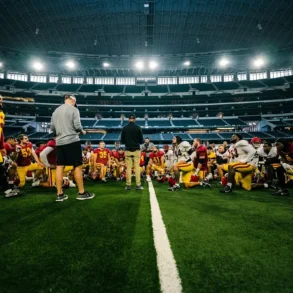
U.S District Judge Claudia Wilken threatened to deny the long-awaited final approval of three pending antitrust cases against the NCAA if the organization and the Power Five conferences don’t agree to phase-in controversial roster limits that were a part of a wide-ranging 10-year settlement that is set to significantly alter how major college athletics operate in the future.
In an order issued Wednesday afternoon, the veteran judge acknowledged that the court continued to lean toward approving the landmark $2.8 billion settlement in the House vs. NCAA and associated cases, but would only do so if the parties in the lawsuit agreed to modify the final agreement to grandfather in current athletes impacted by the roster limits who otherwise would see their places on teams potentially cut as school comply with the terms of the settlement.
“One way of achieving that could be to modify the settlement agreement to ensure that no [athletes] who have or had a roster spot will lose it as a result of the immediate implementation of the settlement agreement,” Wilken wrote in the order.
The roster limits were only one part of the settlement’s wide-ranging terms but garnered one of the largest number of objections to the agreement when the court held a hearing in early April. As part of the terms currently being weighed by the court, schools who opt into the settlement moving forward will have to comply with stricter limits when it comes to the current number of roster spots a team may have instead of the existing limit of scholarships handed out in various sports.
For example, FBS football teams currently can have a maximum of 85 scholarship players but often have rosters well into the triple digits when factoring in the number of walk-on (i.e. non-scholarship) players who may also be a part of the team. Should the settlement go into effect, teams moving forward would be limited to only 105 players, regardless of their scholarship status. The same is true for other sports such as baseball, which currently can split 11.7 full scholarships among as many as 40 players on the team but will soon see a hard cap of 34 players in a program—all of whom could potentially be given a full scholarship.
On Monday, the NCAA moved to codify many of the settlement’s terms into the organization’s byzantine rule book, with the Division I Board of Directors approving nine legislative proposals that culled some 153 bylaws in place while formally bringing about a new structure that allows for direct athlete payments from schools as part of revenue-sharing that the settlement calls for.
“My idea there is to grandfather in a group of rostered people. There’s not that many, it’s not that expensive. It would save a lot of goodwill and sermons and angst and unhappiness from a lot of students and their parents,” Wilken told NCAA attorneys during the final settlement hearing that took place the day of the NCAA men’s basketball championship game. “So, why not just do it?”
The NCAA and the Power Five conferences (and their schools) that are defendants in the agreement continued to push back against the notion of changing the settlement to accommodate such a request, however. In the past several months since preliminary approval was given by the court late last year, there has been little movement to acquiesce to the objectors’ issue on the subject. Often, NCAA attorneys have brought up the fact that despite some athletes potentially getting cut as a result of the roster limits getting enacted, the same athletes can still receive the same treatment in the current system if their coaches decide they no longer want them part of their respective program.
It should be noted that Wilken has not expressed any major red flags when it comes to the specific roster limits or even the fact that they exist as part of the settlement in the first place, but rather just that it harms the current group of players who could see their spots taken in the near term as a result of the settlement being finalized and going into effect in July.
All parties have 14 days to consult with an approved mediator to address such issues regarding the roster limits. If they fail to reach some sort of agreement, Wilken rather bluntly suggested that final approval would not be given and a trial could end up taking place in the near future.
“Any disruption that may occur is a problem of Defendants’ and NCAA member schools’ own making,” Wilken noted in the order. “The fact that the Court granted preliminary approval of the settlement agreement should not have been interpreted as an indication that it was certain that the Court would grant final approval.”
While a trial date remains to be determined, Wednesday’s order certainly seemed to shake up the confidence that many throughout college athletics had been operating under that the House settlement was a foregone conclusion this spring.
This post was originally published on this site be sure to check out more of their content.







